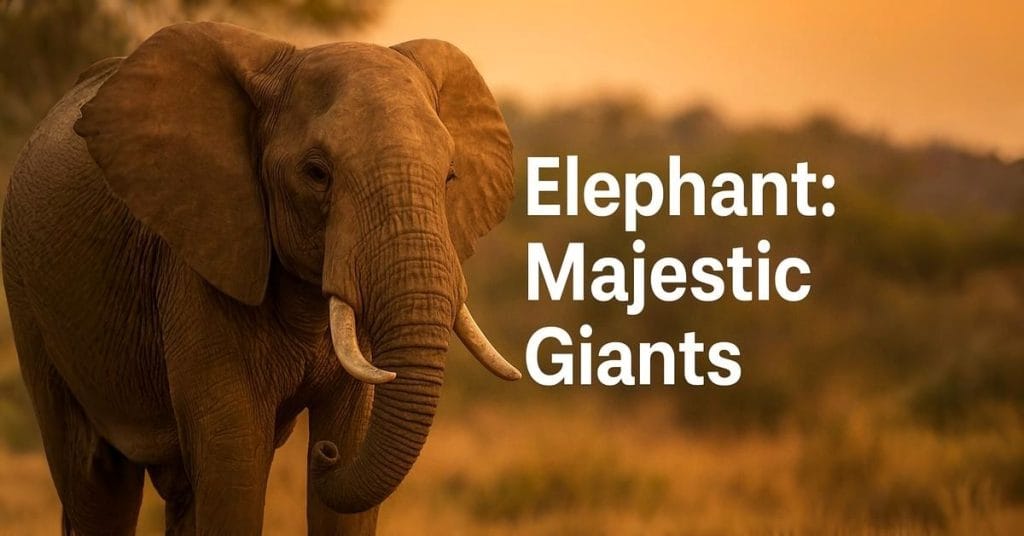Introduction
Elephant are among the most iconic animals on Earth. These gentle giants captivate us with their size, intelligence, and intricate social lives. In this article you’ll learn about elephant species, behavior, habitat, threats, and how people around the world are working to protect them. Whether you’re a student, traveler, or wildlife lover, this guide is written to be clear, friendly, and useful.
What Is an Elephant?
Elephant are large mammals of the family Elephantidae. There are three widely recognized species:
- African bush elephant (Loxodonta africana) — the largest land mammal.
- African forest elephant (Loxodonta cyclotis) — smaller, lives in dense forests.
- Asian elephant (Elephas maximus) — found across South and Southeast Asia.
Each species has unique traits, but they share common features: tusks (in most), large ears, a long trunk, and thick skin. Elephants use their trunk for breathing, drinking, smelling, and manipulating objects.
Anatomy and Key Traits
Elephant physiology is fascinating. Here are the essentials:
Trunk and Tusks
- The trunk is a fusion of the nose and upper lip with about 40,000 muscles.
- Tusks are elongated incisors used for digging, stripping bark, and defense.
Size and Lifespan
- African bush gentle giants—these giants can weigh up to 6,000 kg (13,200 lbs).
- Life expectancy ranges from 50 to 70 years in the wild.
Social Structure
- These giants live in matriarchal herds led by an older female.
- Males often leave the herd at adolescence and may live alone or form bachelor groups.
Behavior and Intelligence
These giants’ intelligence is well-documented. They show memory, empathy, and problem-solving skills.
- They use tools—branches for swatting flies or scratching.
- They mourn their dead and return to bones or burial sites.
- Complex vocalizations and infrasound allow communication over long distances.
Moreover, their strong social bonds and cooperative care for calves make elephant societies uniquely rich.
Habitat and Range
These giants inhabit diverse environments:
- African bush elephant: savannas, grasslands, and open forests.
- African forest elephant: tropical rainforests of Central and West Africa.
- Asian elephant: grasslands, rainforests, and scrublands across India, Sri Lanka, and Southeast Asia.
They are ecosystem engineers — by feeding, trampling, and dispersing seeds they shape habitats for many other species.
Threats and Conservation
Sadly, these animal populations face serious threats.
Major Threats
- Poaching for ivory: Illegal trade reduces populations and disrupts social groups.
- Habitat loss: Agriculture, logging, and development fragment ranges.
- Human-elephant conflict: Crop-raiding leads to retaliatory killings.
- Climate change: Alters water and food availability.
Conservation Efforts
- Protected areas and anti-poaching patrols.
- Community-based conservation that gives local people benefits for protecting these animals.
- International bans and regulation on ivory trade.
- Translocation and corridors to reconnect fragmented habitats.
For a detailed species overview and conservation status, check the IUCN Red List or Wikipedia’s elephant page. (Example external link: https://en.wikipedia.org/wiki/Elephant
How You Can Help
Even small actions matter. Here’s what you can do:
- Support credible conservation groups.
- Avoid buying ivory or products made from elephant parts.
- If you travel, choose ethical wildlife sanctuaries and tours.
- Raise awareness through social media and local outreach.
Interesting Facts (Quick Bullets)
- These mammal trunks can hold about 6 liters of water.
- They are one of the few animals that can recognize themselves in a mirror.
- These mammal feet have a fatty pad that cushions their weight and reduces sound when they walk.
- Calves can stand within an hour of birth and begin nursing immediately.
Human-These mammals Conflict: Solutions That Work
Conflict arises when these animals and humans compete for space. Successful strategies include:
- Early-warning systems and mobile alerts.
- Electric fencing with community oversight.
- Crop choices that deter these animals.
- Land-use planning that includes wildlife corridors.
Community-led approaches are often the most sustainable because they balance local livelihoods with conservation.
These mammals in Culture and Economy
These mammals hold cultural importance in many societies — from religious symbols to national emblems. They also support eco-tourism, which can provide income to local communities while incentivizing protection.
These mammals are extraordinary animals that deserve our respect and protection. By learning about their needs and supporting smart conservation solutions, we can ensure these majestic giants survive for generations. If you care about wildlife, start today: support a verified conservation group, share accurate information, or choose ethical wildlife tourism. Together we can make a difference.
Call to action: Want more on how to help? Subscribe to our newsletter for monthly tips on wildlife protection and ethical travel.

